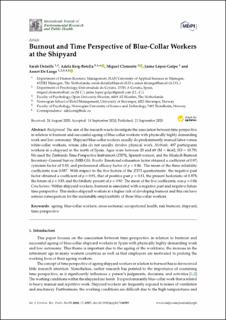| dc.contributor.author | Detaille, Sarah | |
| dc.contributor.author | Reig-Botella, Adela | |
| dc.contributor.author | Clemente, Miguel | |
| dc.contributor.author | López-Golpe, Jaime | |
| dc.contributor.author | De Lange, Annet Harmke | |
| dc.date.accessioned | 2023-02-08T14:53:14Z | |
| dc.date.available | 2023-02-08T14:53:14Z | |
| dc.date.created | 2020-10-06T11:29:12Z | |
| dc.date.issued | 2020 | |
| dc.identifier.citation | Detaille, S., Reig-Botella, A., Clemente, M., López-Golpe, J., & De Lange, A. (2020). Burnout and time perspective of blue-collar workers at the shipyard. International Journal of Environmental Research and Public Health, 17(18), 6905. | en_US |
| dc.identifier.issn | 1661-7827 | |
| dc.identifier.uri | https://hdl.handle.net/11250/3049420 | |
| dc.description.abstract | Background: The aim of the research was to investigate the association between time perspective in relation to burnout and successful ageing of blue-collar workers with physically highly demanding work and low autonomy. Shipyard blue-collar workers usually do predominantly manual labor versus white-collar workers, whose jobs do not usually involve physical work. Methods: 497 participants workers in a shipyard in the north of Spain. Ages were between 20 and 69 (M = 46.62, SD = 10.79). We used the Zimbardo Time Perspective Instrument (ZTPI), Spanish version, and the Maslach Burnout Inventory–General Survey (MBI-GS). Results: Emotional exhaustion factor obtained a coefficient of 0.97; cynicism factor of 0.83; and professional efficacy factor of p = 0.86. The mean of the three reliability coefficients was 0.887. With respect to the five factors of the ZTPI questionnaire: the negative past factor obtained a coefficient of p = 0.91; that of positive past p = 0.81; the present hedonistic of 0.878; the future of p = 0.83; and the fatalistic present of p = 0.90. The mean of the five coefficients, was p = 0.86. Conclusions: Within shipyard workers, burnout is associated with a negative past and negative future time perspective. This makes shipyard workers at a higher risk of developing burnout and this can have serious consequences for the sustainable employability of these blue-collar workers. | en_US |
| dc.language.iso | eng | en_US |
| dc.publisher | MDPI | en_US |
| dc.rights | Navngivelse 4.0 Internasjonal | * |
| dc.rights.uri | http://creativecommons.org/licenses/by/4.0/deed.no | * |
| dc.title | Burnout and Time Perspective of Blue-Collar Workers at the Shipyard | en_US |
| dc.type | Peer reviewed | en_US |
| dc.type | Journal article | en_US |
| dc.description.version | publishedVersion | en_US |
| dc.rights.holder | The authors | en_US |
| dc.subject.nsi | VDP::Samfunnsvitenskap: 200 | en_US |
| dc.source.pagenumber | 10 | en_US |
| dc.source.volume | 17 | en_US |
| dc.source.journal | International Journal of Environmental Research and Public Health | en_US |
| dc.identifier.doi | 10.3390/ijerph17186905 | |
| dc.identifier.cristin | 1837499 | |
| cristin.ispublished | true | |
| cristin.fulltext | original | |
| cristin.qualitycode | 1 | |

